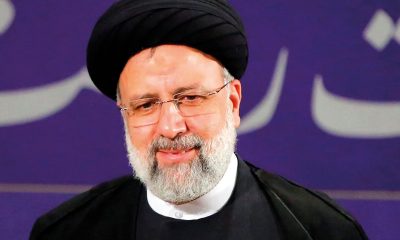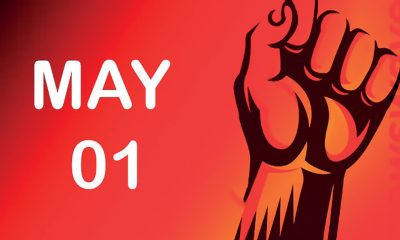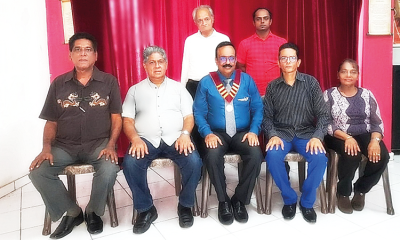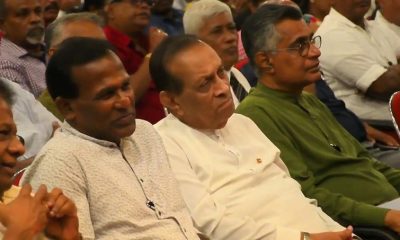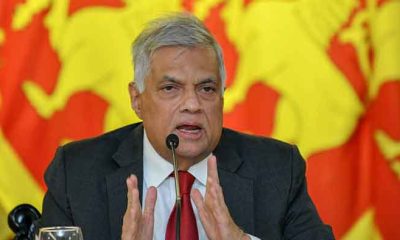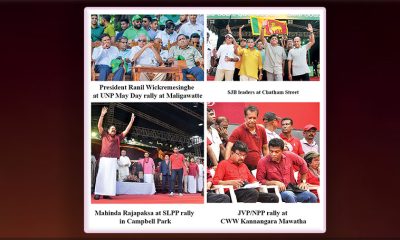Features
What’s in a Suit? That which is substantive can be delivered in a Bush Shirt!

by Rajan Philips
Never mind what Anura Kumara Dissanayake wore in Delhi. Never mind what Ranil Wickremesinghe wears daily. What the people want is not the word salads of sartorial politics by Sunday pundits, but the proffering of substantive politics by contenders for political office. As the pre-election dust takes its own time to settle, two figures are emerging as the primary contenders.
On the right, where he has always been, is Ranil Wickremesinghe. On the left, where he seems inspired to be, is Anura Kumara Dissanayake. If there was any chance of someone racing up the middle, that chance and the politics of that candidate are fast withering. The political house of Sajith Premadasa is a house divided according to insiders and outsiders. Mr. Premadasa will have to put his own house in order before he can be a serious contender for public office.
The impending contest between Ranil Wickremesinghe and Anura Kumara Dissanayake will be a very different one when compared to past presidential elections. First to be noted is the organizational disarray of the mainstream political parties and their electorally opportunistic alliances. The disarray is obvious and needs no elaboration.
It also explains why President Wickremesinghe, the nearly 50-year veteran of a 77 year old party, is still looking for a political launcher for his presidential candidacy. Officially, he will be a UNP candidate with the elephant symbol, but he is looking to be acclaimed as the candidate of a grand alliance. Media columnists are writing about such an alliance, but there are no signs yet of any alliance, let alone a grand one.
The support for President Wickremesinghe is mainly based on his successful stabilization of the economy from where his predecessor left and ran away. Those who are genuinely and perhaps exclusively concerned about the economy do think that Ranil Wickremesinghe should be elected as President to continue managing the economy. But this premise has at least two limitations.
A tentative candidate
One, while it is fair to give Mr. Wickremesinghe credit for what he has done, it would be a stretch to claim that what he has done is something miraculous and that he should contest and be elected President for a new term to continue performing economic miracles. The economy cannot be restored by magic or miracles, and no one should lose sight of the fact that the current stability is primarily due to the moratorium on debt payment. What happens when debt repayment is restarted?
The second limitation to the Wickremesinghe candidacy is that the support for Mr. Wickremesinghe is neither broad nor deep. Otherwise, he should be the one who is topping opinion polls and creating the buzz that Ranil is the man to beat. Mr. Wickremesinghe himself is quite coy about his candidacy. Either he is keeping everyone guessing, or he is guessing himself.
It may be that the President is looking for a broad appeal imploring him to contest the presidential election to keep saving the economy. Similar to the circumstance in which he acceded to the desperate request of Gotabaya Rajapaksa for a helping hand. But there is nothing like that happening now. No appeal by any credible alliance for Ranil to be a candidate. The whole tentativeness of the situation is a symptom of the disarray of the political establishment.
That brings me to the second unique aspect of the upcoming presidential election. That is the emergence of the JVP/NPP as real contender for winning power democratically, and whose unity of purpose and organizational discipline stand in stirring contrast to the opportunism and disarray of the mainstream parties. The JVP’s emergence as a viable contender is as much due to its own maturity as it is due to resonating objective conditions.
The aragalaya that drove Gota away may have turned the tide for the JVP. But it goes beyond that, and it shows the people’s real hunger for an alternative political leadership. And it shows that the people are not warming up to Ranil Wickremesinghe in spite of all the learned views about his capabilities as an economic manager.
AKD’s leadership
The consolidation of the JVP and the emergence of the NPP as its electoral front also owe a great deal to the seemingly collegial leadership of Anura Kumara Dissanayake. He is unique in Sri Lankan politics as the one political leader who has filtered up through the social layers among the Sinhalese without being part of a mainstream political party – the UNP, the SLFP, and later the SLPP. The devolution of political leadership in Sri Lanka – i.e., the transitioning of political leadership from the decadent upper strata of society to the emerging generations – could be a study in itself.
The fact of the matter is that such a transitioning has not been as common in Sri Lanka as it has been in India. There is a long trace of leadership transitioning in India – from the rise of K. Kamaraj as Chief Minister of Madras State (now Tamil Nadu) in 1954, to the ascent of Narendra Modi first as Chief Minister of Gujarat and now the soon to be ‘threepeat’ Prime Minister of India. There is nothing common about their politics, but they represent the shifting of leadership from the upper echelons to the lower strata of India’s hugely stratified society. The example of President Premadasa could be cited as an exception, but it was an exception that could not become a trend.
The JVP and the LTTE interventions could be seen as violent and misplaced efforts to force a transitioning of leadership. Both efforts ended in failure, but the reality now is that even the traditional leadership formations have now imploded. There was a much touted recent transitioning in Tamil political leadership, but that seems to have got mired in legal battles in district courts.
The saving grace here is in the recourse to court battles instead of gun battles. There have been shifts in leadership among the Muslims and estate Tamils, but even the new organizations representing the two communities have become mere appendages to mainstream alliances. They too are suffering from the organizational disarray of their mainstream principals.
In this scheme of unfolding disarray, it is fair to acknowledge the leadership and organizational achievements of Anura Kumara Dissanayake, the JVP and the NPP. This is not to say that they are going to win the upcoming elections and that they are going to provide a pathbreaking new government for Sri Lanka. Those proofs will come in whatever puddings they make.
For now, as a point of political observation, what AKD has done so far needs to be acknowledged. India seems to have done that, and it is irrelevant to the current argument why India may have chosen to do that. More to the point, there has been no Indian invitation yet, not even a hint of it, to the newly elected leader of the ITAK.
The gripe over AKD’s Indian visit is really a symptom of the uneasiness in political circles that are unable to come to grips with the disarray among the mainstream political parties and their alliances. Not to mention that for a host of good and bad reasons, the arrival of the JVP/NPP as a palpable parliamentary force is not palatable to many in the commentating business. It is again a symptom of the mainstream disarray that criticisms of JVP/NPP are emanating almost exclusively outside of parliament and from outside formal political organizations. Conversely, it is this vacuum that the JVP/NPP is filling up much to the irritation of its socio-genital opponents.
Their politics and ours
The task for Anura Kumara Dissanayake and the JVP/NPP is to respond to the sartorial politics of their critics with substantive politics of their own. “Their Politics and Ours,” the title of an old pamphlet that Dr. Colvin R de Silva wrote in the early 1950s, takes a different meaning in the new context in which the JVP/NPP is emerging as a real parliamentary contender.
Dr Colvin was intervening in the perennial debates within the left movement in the heady days of the Old Left. That was then. Now, Anura Kumara Dissanayake does not have to get into polemic battles with anyone on the Left. He is in fact the only one on the Left, electorally speaking. He has to differentiate his politics from that of his media critics.
There is another difference between the heady days of the Old Left and Sri Lanka’s desperate times after the Rajapaksa yugaya. The challenge today is not to advance the cause of socialism but to salvage the economy from the pits that it has fallen into. Sri Lanka’s economic irony cannot be any stalker, in that Sri Lanka and Pakistan are two economic laggards in South Asia that is now seen as the principal growth region for an unevenly sputtering world economy.
India is virtually the sole economic engine of the South Asian region, and the challenge facing Sri Lanka is to get in stride with ongoing regional growth instead of lagging behind it.
The challenge facing JVP/NPP is to generate confidence about its abilities for managing the economy the same way it is demonstrating its abilities for political mobilization. As a political organization it does not have to rely on its leaders to read economic textbooks the way Che Guvera read them after the Cuban revolution.
There are enough economists and economic thinktanks in Sri Lanka and the JVP/NPP should not feel shy about tapping them for ideas and as resources. There should be reaching out to professional resources in a very public way to enhance public confidence at the national level, the same way retired military and police officers are reportedly being enlisted at the electoral district levels.
Besides the economy, the JVP/NPP leadership will have to deal with the question of constitutional reform and clarify its position on what could still be called the island’s national question. On the question of abolishing the executive presidency, Mr. Dissanayake has provided a convincing response: there is no time to do it before the presidential election.
President Wickremesinghe has said the same thing, but the difference between the two is that while Mr. Dissanayake is committed to abolishing the presidency, Mr. Wickremesinghe is not. That is a big difference, and one on which Mr. Dissanayake could and should publicly challenge the interim President.
Features
The heart-friendly health minister

by Dr Gotabhya Ranasinghe
Senior Consultant Cardiologist
National Hospital Sri Lanka
When we sought a meeting with Hon Dr. Ramesh Pathirana, Minister of Health, he graciously cleared his busy schedule to accommodate us. Renowned for his attentive listening and deep understanding, Minister Pathirana is dedicated to advancing the health sector. His openness and transparency exemplify the qualities of an exemplary politician and minister.
Dr. Palitha Mahipala, the current Health Secretary, demonstrates both commendable enthusiasm and unwavering support. This combination of attributes makes him a highly compatible colleague for the esteemed Minister of Health.
Our discussion centered on a project that has been in the works for the past 30 years, one that no other minister had managed to advance.
Minister Pathirana, however, recognized the project’s significance and its potential to revolutionize care for heart patients.
The project involves the construction of a state-of-the-art facility at the premises of the National Hospital Colombo. The project’s location within the premises of the National Hospital underscores its importance and relevance to the healthcare infrastructure of the nation.
This facility will include a cardiology building and a tertiary care center, equipped with the latest technology to handle and treat all types of heart-related conditions and surgeries.
Securing funding was a major milestone for this initiative. Minister Pathirana successfully obtained approval for a $40 billion loan from the Asian Development Bank. With the funding in place, the foundation stone is scheduled to be laid in September this year, and construction will begin in January 2025.
This project guarantees a consistent and uninterrupted supply of stents and related medications for heart patients. As a result, patients will have timely access to essential medical supplies during their treatment and recovery. By securing these critical resources, the project aims to enhance patient outcomes, minimize treatment delays, and maintain the highest standards of cardiac care.
Upon its fruition, this monumental building will serve as a beacon of hope and healing, symbolizing the unwavering dedication to improving patient outcomes and fostering a healthier society.We anticipate a future marked by significant progress and positive outcomes in Sri Lanka’s cardiovascular treatment landscape within the foreseeable timeframe.
Features
A LOVING TRIBUTE TO JESUIT FR. ALOYSIUS PIERIS ON HIS 90th BIRTHDAY

by Fr. Emmanuel Fernando, OMI
Jesuit Fr. Aloysius Pieris (affectionately called Fr. Aloy) celebrated his 90th birthday on April 9, 2024 and I, as the editor of our Oblate Journal, THE MISSIONARY OBLATE had gone to press by that time. Immediately I decided to publish an article, appreciating the untiring selfless services he continues to offer for inter-Faith dialogue, the renewal of the Catholic Church, his concern for the poor and the suffering Sri Lankan masses and to me, the present writer.
It was in 1988, when I was appointed Director of the Oblate Scholastics at Ampitiya by the then Oblate Provincial Fr. Anselm Silva, that I came to know Fr. Aloy more closely. Knowing well his expertise in matters spiritual, theological, Indological and pastoral, and with the collaborative spirit of my companion-formators, our Oblate Scholastics were sent to Tulana, the Research and Encounter Centre, Kelaniya, of which he is the Founder-Director, for ‘exposure-programmes’ on matters spiritual, biblical, theological and pastoral. Some of these dimensions according to my view and that of my companion-formators, were not available at the National Seminary, Ampitiya.
Ever since that time, our Oblate formators/ accompaniers at the Oblate Scholasticate, Ampitiya , have continued to send our Oblate Scholastics to Tulana Centre for deepening their insights and convictions regarding matters needed to serve the people in today’s context. Fr. Aloy also had tried very enthusiastically with the Oblate team headed by Frs. Oswald Firth and Clement Waidyasekara to begin a Theologate, directed by the Religious Congregations in Sri Lanka, for the contextual formation/ accompaniment of their members. It should very well be a desired goal of the Leaders / Provincials of the Religious Congregations.
Besides being a formator/accompanier at the Oblate Scholasticate, I was entrusted also with the task of editing and publishing our Oblate journal, ‘The Missionary Oblate’. To maintain the quality of the journal I continue to depend on Fr. Aloy for his thought-provoking and stimulating articles on Biblical Spirituality, Biblical Theology and Ecclesiology. I am very grateful to him for his generous assistance. Of late, his writings on renewal of the Church, initiated by Pope St. John XX111 and continued by Pope Francis through the Synodal path, published in our Oblate journal, enable our readers to focus their attention also on the needed renewal in the Catholic Church in Sri Lanka. Fr. Aloy appreciated very much the Synodal path adopted by the Jesuit Pope Francis for the renewal of the Church, rooted very much on prayerful discernment. In my Religious and presbyteral life, Fr.Aloy continues to be my spiritual animator / guide and ongoing formator / acccompanier.
Fr. Aloysius Pieris, BA Hons (Lond), LPh (SHC, India), STL (PFT, Naples), PhD (SLU/VC), ThD (Tilburg), D.Ltt (KU), has been one of the eminent Asian theologians well recognized internationally and one who has lectured and held visiting chairs in many universities both in the West and in the East. Many members of Religious Congregations from Asian countries have benefited from his lectures and guidance in the East Asian Pastoral Institute (EAPI) in Manila, Philippines. He had been a Theologian consulted by the Federation of Asian Bishops’ Conferences for many years. During his professorship at the Gregorian University in Rome, he was called to be a member of a special group of advisers on other religions consulted by Pope Paul VI.
Fr. Aloy is the author of more than 30 books and well over 500 Research Papers. Some of his books and articles have been translated and published in several countries. Among those books, one can find the following: 1) The Genesis of an Asian Theology of Liberation (An Autobiographical Excursus on the Art of Theologising in Asia, 2) An Asian Theology of Liberation, 3) Providential Timeliness of Vatican 11 (a long-overdue halt to a scandalous millennium, 4) Give Vatican 11 a chance, 5) Leadership in the Church, 6) Relishing our faith in working for justice (Themes for study and discussion), 7) A Message meant mainly, not exclusively for Jesuits (Background information necessary for helping Francis renew the Church), 8) Lent in Lanka (Reflections and Resolutions, 9) Love meets wisdom (A Christian Experience of Buddhism, 10) Fire and Water 11) God’s Reign for God’s poor, 12) Our Unhiddden Agenda (How we Jesuits work, pray and form our men). He is also the Editor of two journals, Vagdevi, Journal of Religious Reflection and Dialogue, New Series.
Fr. Aloy has a BA in Pali and Sanskrit from the University of London and a Ph.D in Buddhist Philosophy from the University of Sri Lankan, Vidyodaya Campus. On Nov. 23, 2019, he was awarded the prestigious honorary Doctorate of Literature (D.Litt) by the Chancellor of the University of Kelaniya, the Most Venerable Welamitiyawe Dharmakirthi Sri Kusala Dhamma Thera.
Fr. Aloy continues to be a promoter of Gospel values and virtues. Justice as a constitutive dimension of love and social concern for the downtrodden masses are very much noted in his life and work. He had very much appreciated the commitment of the late Fr. Joseph (Joe) Fernando, the National Director of the Social and Economic Centre (SEDEC) for the poor.
In Sri Lanka, a few religious Congregations – the Good Shepherd Sisters, the Christian Brothers, the Marist Brothers and the Oblates – have invited him to animate their members especially during their Provincial Congresses, Chapters and International Conferences. The mainline Christian Churches also have sought his advice and followed his seminars. I, for one, regret very much, that the Sri Lankan authorities of the Catholic Church –today’s Hierarchy—- have not sought Fr.
Aloy’s expertise for the renewal of the Catholic Church in Sri Lanka and thus have not benefited from the immense store of wisdom and insight that he can offer to our local Church while the Sri Lankan bishops who governed the Catholic church in the immediate aftermath of the Second Vatican Council (Edmund Fernando OMI, Anthony de Saram, Leo Nanayakkara OSB, Frank Marcus Fernando, Paul Perera,) visited him and consulted him on many matters. Among the Tamil Bishops, Bishop Rayappu Joseph was keeping close contact with him and Bishop J. Deogupillai hosted him and his team visiting him after the horrible Black July massacre of Tamils.
Features
A fairy tale, success or debacle

Sri Lanka-Singapore Free Trade Agreement
By Gomi Senadhira
senadhiragomi@gmail.com
“You might tell fairy tales, but the progress of a country cannot be achieved through such narratives. A country cannot be developed by making false promises. The country moved backward because of the electoral promises made by political parties throughout time. We have witnessed that the ultimate result of this is the country becoming bankrupt. Unfortunately, many segments of the population have not come to realize this yet.” – President Ranil Wickremesinghe, 2024 Budget speech
Any Sri Lankan would agree with the above words of President Wickremesinghe on the false promises our politicians and officials make and the fairy tales they narrate which bankrupted this country. So, to understand this, let’s look at one such fairy tale with lots of false promises; Ranil Wickremesinghe’s greatest achievement in the area of international trade and investment promotion during the Yahapalana period, Sri Lanka-Singapore Free Trade Agreement (SLSFTA).
It is appropriate and timely to do it now as Finance Minister Wickremesinghe has just presented to parliament a bill on the National Policy on Economic Transformation which includes the establishment of an Office for International Trade and the Sri Lanka Institute of Economics and International Trade.
Was SLSFTA a “Cleverly negotiated Free Trade Agreement” as stated by the (former) Minister of Development Strategies and International Trade Malik Samarawickrama during the Parliamentary Debate on the SLSFTA in July 2018, or a colossal blunder covered up with lies, false promises, and fairy tales? After SLSFTA was signed there were a number of fairy tales published on this agreement by the Ministry of Development Strategies and International, Institute of Policy Studies, and others.
However, for this article, I would like to limit my comments to the speech by Minister Samarawickrama during the Parliamentary Debate, and the two most important areas in the agreement which were covered up with lies, fairy tales, and false promises, namely: revenue loss for Sri Lanka and Investment from Singapore. On the other important area, “Waste products dumping” I do not want to comment here as I have written extensively on the issue.
1. The revenue loss
During the Parliamentary Debate in July 2018, Minister Samarawickrama stated “…. let me reiterate that this FTA with Singapore has been very cleverly negotiated by us…. The liberalisation programme under this FTA has been carefully designed to have the least impact on domestic industry and revenue collection. We have included all revenue sensitive items in the negative list of items which will not be subject to removal of tariff. Therefore, 97.8% revenue from Customs duty is protected. Our tariff liberalisation will take place over a period of 12-15 years! In fact, the revenue earned through tariffs on goods imported from Singapore last year was Rs. 35 billion.
The revenue loss for over the next 15 years due to the FTA is only Rs. 733 million– which when annualised, on average, is just Rs. 51 million. That is just 0.14% per year! So anyone who claims the Singapore FTA causes revenue loss to the Government cannot do basic arithmetic! Mr. Speaker, in conclusion, I call on my fellow members of this House – don’t mislead the public with baseless criticism that is not grounded in facts. Don’t look at petty politics and use these issues for your own political survival.”
I was surprised to read the minister’s speech because an article published in January 2018 in “The Straits Times“, based on information released by the Singaporean Negotiators stated, “…. With the FTA, tariff savings for Singapore exports are estimated to hit $10 million annually“.
As the annual tariff savings (that is the revenue loss for Sri Lanka) calculated by the Singaporean Negotiators, Singaporean $ 10 million (Sri Lankan rupees 1,200 million in 2018) was way above the rupees’ 733 million revenue loss for 15 years estimated by the Sri Lankan negotiators, it was clear to any observer that one of the parties to the agreement had not done the basic arithmetic!
Six years later, according to a report published by “The Morning” newspaper, speaking at the Committee on Public Finance (COPF) on 7th May 2024, Mr Samarawickrama’s chief trade negotiator K.J. Weerasinghehad had admitted “…. that forecasted revenue loss for the Government of Sri Lanka through the Singapore FTA is Rs. 450 million in 2023 and Rs. 1.3 billion in 2024.”
If these numbers are correct, as tariff liberalisation under the SLSFTA has just started, we will pass Rs 2 billion very soon. Then, the question is how Sri Lanka’s trade negotiators made such a colossal blunder. Didn’t they do their basic arithmetic? If they didn’t know how to do basic arithmetic they should have at least done their basic readings. For example, the headline of the article published in The Straits Times in January 2018 was “Singapore, Sri Lanka sign FTA, annual savings of $10m expected”.
Anyway, as Sri Lanka’s chief negotiator reiterated at the COPF meeting that “…. since 99% of the tariffs in Singapore have zero rates of duty, Sri Lanka has agreed on 80% tariff liberalisation over a period of 15 years while expecting Singapore investments to address the imbalance in trade,” let’s turn towards investment.
Investment from Singapore
In July 2018, speaking during the Parliamentary Debate on the FTA this is what Minister Malik Samarawickrama stated on investment from Singapore, “Already, thanks to this FTA, in just the past two-and-a-half months since the agreement came into effect we have received a proposal from Singapore for investment amounting to $ 14.8 billion in an oil refinery for export of petroleum products. In addition, we have proposals for a steel manufacturing plant for exports ($ 1 billion investment), flour milling plant ($ 50 million), sugar refinery ($ 200 million). This adds up to more than $ 16.05 billion in the pipeline on these projects alone.
And all of these projects will create thousands of more jobs for our people. In principle approval has already been granted by the BOI and the investors are awaiting the release of land the environmental approvals to commence the project.
I request the Opposition and those with vested interests to change their narrow-minded thinking and join us to develop our country. We must always look at what is best for the whole community, not just the few who may oppose. We owe it to our people to courageously take decisions that will change their lives for the better.”
According to the media report I quoted earlier, speaking at the Committee on Public Finance (COPF) Chief Negotiator Weerasinghe has admitted that Sri Lanka was not happy with overall Singapore investments that have come in the past few years in return for the trade liberalisation under the Singapore-Sri Lanka Free Trade Agreement. He has added that between 2021 and 2023 the total investment from Singapore had been around $162 million!
What happened to those projects worth $16 billion negotiated, thanks to the SLSFTA, in just the two-and-a-half months after the agreement came into effect and approved by the BOI? I do not know about the steel manufacturing plant for exports ($ 1 billion investment), flour milling plant ($ 50 million) and sugar refinery ($ 200 million).
However, story of the multibillion-dollar investment in the Petroleum Refinery unfolded in a manner that would qualify it as the best fairy tale with false promises presented by our politicians and the officials, prior to 2019 elections.
Though many Sri Lankans got to know, through the media which repeatedly highlighted a plethora of issues surrounding the project and the questionable credentials of the Singaporean investor, the construction work on the Mirrijiwela Oil Refinery along with the cement factory began on the24th of March 2019 with a bang and Minister Ranil Wickremesinghe and his ministers along with the foreign and local dignitaries laid the foundation stones.
That was few months before the 2019 Presidential elections. Inaugurating the construction work Prime Minister Ranil Wickremesinghe said the projects will create thousands of job opportunities in the area and surrounding districts.
The oil refinery, which was to be built over 200 acres of land, with the capacity to refine 200,000 barrels of crude oil per day, was to generate US$7 billion of exports and create 1,500 direct and 3,000 indirect jobs. The construction of the refinery was to be completed in 44 months. Four years later, in August 2023 the Cabinet of Ministers approved the proposal presented by President Ranil Wickremesinghe to cancel the agreement with the investors of the refinery as the project has not been implemented! Can they explain to the country how much money was wasted to produce that fairy tale?
It is obvious that the President, ministers, and officials had made huge blunders and had deliberately misled the public and the parliament on the revenue loss and potential investment from SLSFTA with fairy tales and false promises.
As the president himself said, a country cannot be developed by making false promises or with fairy tales and these false promises and fairy tales had bankrupted the country. “Unfortunately, many segments of the population have not come to realize this yet”.
(The writer, a specialist and an activist on trade and development issues . )


